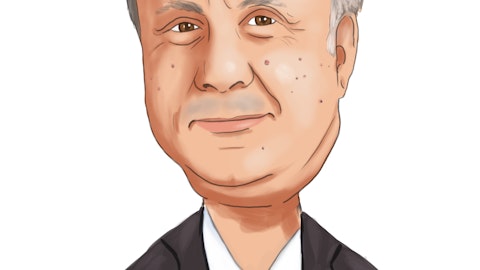So I think it speaks to the fact that, as I said, this is a really strong biomarker in my mind to have this kind of demand from centers and from patients. With regards to how would this logistically be administered here in the US, it typically is a direct submission from the PI. I would think of this as more like classical compassionate use as opposed to some of the EAPs we know of when drugs are approved and we’re waiting for them to get to the market. So this would be an individual PI at their center cross-referencing our ILD and submitting into the FDA. Because we have some of those positive risk evaluations from a DSMB perspective, we feel as though we’re also in good shape to support this vertical. And we may provide small grants to kind of help patients with some of their travel or maybe even some infusion costs.
That’s going to be on a case-by-case level. But this will be something that the centers themselves will bear a little bit more of the financial burden, if you will. We’ll provide drug for free and we’re in good shape from a drug supply perspective. But I do not expect, nor should any of the investors expect, that this will materially impact really our cash position. We have the drug, we have the drug supply. We’ll help out with some administrative templates and things like that and maybe perhaps some small stipends to help patients. When you look at Europe, you look at other places around the world, that’s going to be really a little bit more specific. Each country, for example, in Europe, some of them have more formal pathways that are more streamlined, similar to here in the US.
Other regions, we’re working more closely with individual hospitals in determining how best to provide drug to those patients that want it. So it’s an atypical program, but I also think it speaks to our commitment to really respond to this demand from patients and PIs.
Joe Pantginis: Very, very helpful. And then I guess when you consider being in a pivotal study right now that we’ll go into, call it roughly mid next year and the Phase 2 SSc study, how would you sort of characterize at this moment your manufacturing needs to get beyond that and to potential commercialization for EFZO?
Sanjay Shukla: Yeah, so we had transitioned a few years ago to a more commercially oriented and scalable type of partnership. So we’re in really good shape here to essentially have drug manufactured, clear all the hurdles also with the FDA to support a launch with some of those initial batches and runs more or less mapped out here. Of course, — if you go out five, seven years from now, I wouldn’t say we have that type of capacity, but in the short term here to get through our clinical program and the early commercialization work, we’re in good shape here. And we’re also fortunate that the manufacturers here in the US, so we have good control, good line of sight. I know things are happening worldwide with manufacturers right now where there’s a lot of controversy if it’s not US based, but we’re de-risked there as well by having a good manufacturing plan.
That we also spend a lot of time talking to regulators with to make sure –they want to make sure that we have that drug product ready for patients because there’s going to be a high amount of demand assuming this drug gets approved. These patients have been, as I said, waiting for a therapy their whole lives.
Joe Pantginis: Well, that five to seven year comment would be a great problem to have, but thanks for all the comments, Sanjay.
Sanjay Shukla: Sure.
Operator: Thank you. Our next question comes from Yasmeen Rahimi with Piper Sandler. You may proceed.
Unidentified Analyst: Hey, Dean, this is for Yas. Congrats on the continued progress and thanks for taking our questions. For EFZO-FIT, do you still need additional sites to bring enrollment to the finish line? And is there actually an opportunity for additional enrollment beyond the 264 patients? And second, could you provide more color on the percentage or number of patients continuing from EFZO-FIT to the EAP program?
Sanjay Shukla: Yeah, so 264 is kind of our goal. A lot of that is based on our power calculations. It assumes that you can have a nominal dropout rate. So we’re well-powered, actually overpowered in many ways compared to other Phase 3 trials. 92% powered here, 264 is our goal we still view that as a solid number there. It allows for also a buffer that if you had 10% of the patients discontinue for any reason, you’d still be able to hit your power calculation. So we’re still set with that number sometimes you can see trials that might be a few patients over or a few patients under. A lot of that has to do with patient screening right there at the end. In our last trial, which was the 36 patient trial, we had eligible patients the day we stopped screening.
We ended up having a few more patients, one more patient enrolled in that trial because they were screen eligible and we don’t want sort of shut down enrollment if someone is already screened and is eligible. So I would say that we’re still going to be right in that ballpark there of 264. With regards to how many are going to move into the EAP, we don’t know yet. We are continuing to generate requests. As you can imagine, as more and more patients finish the trial, we may get more patients interested. My early read on it is we’re well built here to have a substantial number of patients. If they want the drug, we’re ready to provide it. But I don’t have an exact number, but we are prepared to potentially give the EAP program, have it there for a very, very large number of patients.
We’ll have to wait and see what kind of demand it continues. Early on right now, I will say, since we put the announcement, we probably had even more demand since we put the announcement out.
Operator: Thank you. Our next question comes from Yale Jen Laidlaw & Co. You may proceed.




